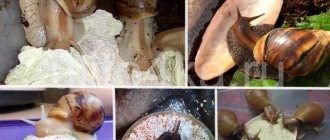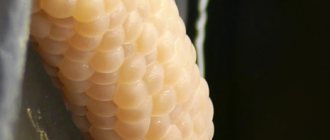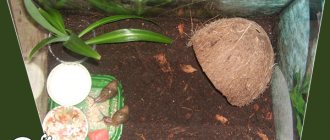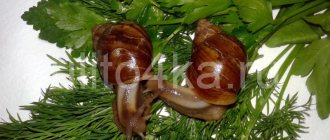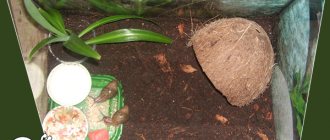Reproduction of Achatina mollusks at home requires care and attention on the part of the owner. These land animals are hermaphrodites (they have both male and female characteristics); Achatina reproduces well even in captivity. Before you start breeding, it is important to understand that Achatina snail eggs are laid in large quantities. It is necessary to create a favorable atmosphere that will be beneficial for future Achatina snails.
Preparation for reproduction
In the Achatina snail, reproduction occurs only if the aquarium or terrarium meets certain requirements. Despite the fact that Achatina are hermaphrodites, they need a partner in order to mate. To reproduce, a pair of Achatina must be moved to a separate container.
In order to breed healthy and full-fledged offspring, you need to create the following living conditions for mollusks:
- the size of the aquarium must be at least 15 liters;
- no temperature changes, it should stay around 27–28 degrees;
- It is recommended to cover the bottom of the aquarium with 100 mm thick damp coconut soil;
- for pregnant Achatina, as well as after laying eggs, add calcium to food;
- The terrarium must be kept clean.
The following is used as a supplement containing calcium:
- chalk stone;
- mineral stone;
- sepia;
- small shell rock.
Gender of the snail
The question of determining the sex of an individual is of interest to every breeder; as stated earlier, they have no sexual differences; it is impossible to determine the sex and divide snails into male and female. Achatina cannot reproduce alone, without a partner; a companion is needed for mating. The eldest large individual becomes the female. This is due to the fact that pregnancy requires a lot of physical strength, therefore, the strongest representatives are selected in order to ensure healthy offspring.
Pair of Achatina snails
Stimulation of reproduction
Stimulating a mollusk to reproduce consists primarily of organizing all the necessary conditions related to preparation for mating. The terrarium should be thoroughly washed and cleaned; if the soil is dry and its thickness does not reach 10 cm, then it should be replaced. The soil must be clean. Artificial ponds should be temporarily removed from the terrarium. It is also important to make sure that only healthy Achatina mates.
Caracolus
Sexual maturity in tree snails occurs at 11–13 months. Both partners are capable of producing offspring.
Laying sometimes occurs several months after fertilization. The number of eggs in it is 10 - 15 pieces.
The incubation period lasts 10 – 14 days at +24C -+26C. When the temperature rises by 2–3 degrees, the birth of babies can be expected within 5–6 days.
Reproduction of Achatina
Reproduction of Achatina snails is possible only with the onset of puberty. An individual is considered an adult from the moment it reaches the age of 6 months; Achatina is ready for mating after the appearance of a small tubercle on the neck, which is the reproductive organ of snails.
Immediately after the mating process, the time of pregnancy officially begins; during this period, the gastropod lays eggs. Pregnancy is different for every female. On average, Achatina snail eggs hatch in 1–2 months. It is possible to see the hatching eggs of Achatina if you look into the spiracle of Achatina.
There are recorded cases when a snail's pregnancy ends in childbirth, as a result of which Achatina gives birth to viable small mollusks.
The mollusk buries its future offspring in the ground; often for these purposes, Achatina prepares a hole in advance where they lay their eggs. Achatina snails are capable of breeding all year round, in separate places in small groups or together.
Pregnancy has a negative impact on the female; she should be fed well, adding various supplements.
How do Achatina grow?
Kids do not need special conditions or a separate terrarium. Immediately after hatching, they can be placed with their parents.
Individuals are friendly to each other and will not show aggression or try to eat their offspring.
They need to be separated after six months, when the new generation is ready to reproduce. To prevent sexually mature mollusks from reproducing, they will need to be separated.
What do Achatina snail eggs look like?
After Achatina has laid eggs, aquarists can observe their appearance and further development. The clutch of Achatina is similar in appearance to fish eggs, which is why it received its second name, since the snail lays eggs in groups. Initially, caviar is a dense and elastic mucus, but soft to the touch. During the incubation process, snail eggs become harder and a shell appears at the time of hatching. The egg shell of the clutch has green and brown shades.
Achatina eggs
There are cases of false eggs being laid when they do not have a shell and are transparent in color. The shape of the caviar is always round. The size of Achatina eggs varies from 5 to 7 mm, sometimes smaller. Achatina hatch at home in a short period of time, from 17 to 24 hours, so all the offspring can hatch in one day. The number of eggs can reach 300 pieces, but, as a rule, no more than 100 snails hatch. The number of Achatina offspring laid differs from the cubs born. Newborn snails require high-quality care, just like a pregnant gastropod.
How long will it take for snails to hatch from eggs?
Achatina lay white or light yellow eggs. They have an oval shape, the diameter of the egg is 5 mm. The number of eggs in a clutch depends on the type and age of the snail, and ranges from 50 to 500 pieces. The older the snail, the more eggs there will be in the clutch.
After fertilization, about a week later, small testicles can be seen in the respiratory opening of Achatina. The snail carries the eggs in its body for about 2 weeks. Then she digs in the ground and makes a laying. Some mollusks do not bury, but scatter their eggs over the entire surface of the soil.
During the laying period, it is necessary to monitor the snail's diet. Feeding should not be skipped and the amount of calcium in the diet must be increased.
The incubation period lasts from 3 to 5 weeks. The time after which snails will begin to emerge from their eggs depends on how long the snail has been carrying the eggs in its body.
Interesting! If the snail does not like the soil or the conditions are not suitable, it can increase the gestation period and not lay eggs. In this case, hatching can begin a week after laying.
If the snail lays eggs unexpectedly for the owner, that is, the gestation time is unknown, then you have only a week to decide what to do with the eggs.
How to care for Achatina eggs
Small Achatina require minimal care from the breeder. But it is necessary to regularly care for the egg laying and monitor environmental indicators.
If the snail laid eggs in a hole without covering it with soil, then you need to carefully sprinkle the eggs yourself.
It is important to ensure that the soil is moist; if necessary, add a small amount of water, but there should be no liquid under the masonry. The most favorable temperature for egg maturation will be 28 degrees, just as before, sudden changes should not be allowed.
Little Achatina
It is forbidden to touch the masonry with your hands. An exception may be a situation when a snail has deposited it in the territory of the terrarium, then it is necessary to carefully transfer the future offspring into one hole using some object. The temperature of a person's hands can cause harm.
A newborn mollusk grows very slowly and during this time the parents care for their offspring. The baby's shell is delicate and should be handled with care.
What to feed small Achatina snails
Immediately after birth, the mollusks stay inside the substrate for several days, only then they crawl out to the surface, doing this gradually. At first, babies eat eggshells from their own eggs, as well as false eggs. Further, it is recommended to feed small mollusks in the same way as an adult. Feeding should be frequent and regular, and access to food should be constant.
Achatina achatina
Tiger snails, like most representatives of Achatina, after cross-fertilization, lay clutches (both partners) consisting of 200 - 300 eggs.
The incubation period should take place in a container separate from the general terrarium, in moist soil, at +25C + 27C.
After 15 - 25 days, you can expect the appearance of offspring.
Priming
For newborn Achatina leaves, lettuce and cabbage are usually used as soil. The kids sit on these leaves and eat, gaining strength. If small snails are in a terrarium with soil, then give preference to fine coconut substrate and flower soil without fertilizers. It is better to avoid moss in the first months. Sand, stones and sawdust are strictly prohibited as soil. Which soil to choose.
Selection and purchase of snails
All aquarists who have expressed a desire to have Achatina snails must first study the peculiarities of their behavior, maintenance and care. Only after this can you begin searching for and purchasing a gastropod. This event is quite complicated, as it involves considerable financial costs not only for the purchase of the snail, but also for its delivery.
As a rule, only experienced aquarists who know all the nuances of the process and can provide the mollusks with optimal conditions are involved in breeding these gastropods. In addition, they must cooperate with one of the pet stores, where they can check the health of the creatures and correctly determine their value.
When purchasing Achatina, it is important to consider the following nuances:
- It is not recommended to buy snails by hand, as in this case there is no guarantee of their healthy condition.
- You need to observe the behavior of the mollusk for several days and only if there are no obvious signs of any deviations can you buy them.
- It is important to take a closer look at the conditions of keeping Achatina in the pet store. If the requirements for lighting, ventilation or temperature are not met, it is better to refuse the purchase. Otherwise, you can buy a sick individual that has not yet shown obvious signs of illness.
- It is best to buy American or African Achatina with an officially documented pedigree. Only in this case can you be sure that there are no genetic abnormalities associated with their ancestors.
- Before purchasing, it is important to do a thorough inspection of the snail. Its shell should be uniform, without various flaws or defects.
- You should not take an Achatina that was born less than 2 months ago. The best option would be to purchase a gastropod at the age of 3 or 4 months.
Why are Achatina becoming so popular?
Unpretentious and absolutely silent Achatina snails often become inhabitants of the “living corner” in offices. They relieve stress like fish. Many expensive spa salons offer peeling with Achatina snails. Their mucus has an anti-inflammatory and regenerative effect. So why not place such a “cosmetologist” in your home and carry out such procedures yourself? Even if you need to go on a long business trip, or you decide to go to a resort with the whole family, the owner of Achatina will not have to rack his brains with whom to leave the pet during his absence.
If there are no people willing to care for the snail in your absence, then you can simply put it into hibernation. In this state, “closed” in its “house,” the snail can remain for several months without any damage to itself. The uniqueness of snails is that under unfavorable environmental conditions they hibernate and awaken only when these conditions improve significantly. Hibernating a snail is very easy. It is necessary to create dryness in the terrarium and not feed. And in order to wake up, return the previous conditions. Or hold the shell for 10 minutes in warm water.
Types of eggs
A clutch may contain several types of eggs.
- A normal fertilized egg (most of them) with a snail embryo has a dense shell. Its color varies from white to yellowish.
- A fat egg is more like a translucent egg with jelly-like contents. Instead of a shell, it has a thin film. And by its purpose it is a nutrient for future small snails. The number of fat eggs in one clutch usually does not exceed 1 - 2 pieces.
- An unfertilized egg looks like a normal egg, but there is no embryo inside. Most often they are laid by Achatina, who lives alone, without a partner. The number of false eggs does not exceed 10 pieces. for Achatina and 1 - 2 pcs. for archahatina. If a mollusk has a pair, its next clutch will be full.
Temperature regime for small snails
During the first few months, it is important to maintain a constant temperature and humidity in the terrarium with small snails. To do this, place a thermometer and hygrometer. The optimal temperature for keeping Achatina is 25 - 27 degrees. Optimum humidity 65% - 70%. A thermal cord or incandescent lamp will help you maintain the temperature. Humidity - daily spraying with boiled water from a spray bottle.
Cleaning a terrarium with snails
Uneaten food and feces should be removed every day. If this is not done in a warm, humid environment, midges, mold and bacteria quickly grow. Then an unpleasant odor appears and parasites may appear. The snails themselves have no smell; the smell is of decaying food debris. When cleaning a terrarium with small Achatina, carefully inspect uneaten lettuce and cabbage leaves before throwing them in the trash. Sometimes babies can sit on them.



